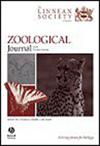High endemic freshwater mussel (Bivalvia: Unionida) diversity in western Borneo, with description of three new species
IF 3
2区 生物学
Q1 ZOOLOGY
引用次数: 0
Abstract
The freshwater mussels (Bivalvia: Unionida) of the biodiversity hotspot Sundaland are experiencing severe anthropogenic threats, whilst their diversity and distribution remain poorly understood. Here, we present the first modern-day data on Unionida diversity and distribution across western Borneo. Mussels were surveyed and collected in the upper Kapuas and Pawan river basins in West Kalimantan, Indonesia, and the Sambas Besar, Sarawak and Batang Sadong river basins in Sarawak, Malaysia. DNA sequencing (COI + 16S + ND1 + 18S + 28S) and morphological analyses were conducted to delineate and identify species, and reconstruct phylogenetic relationships and population genetics. Specimens belonged to six native genera and nine species, of which seven are endemic to Borneo and three are new to science, i.e. Ctenodesma mawonae Zieritz et al., sp. nov., Sarawak basin, and Ctenodesma bersinara Zieritz et al., sp. nov., and Rectidens lauris Zieritz et al., sp. nov., both Pawan basin. The monotypic genera Caudiculatus and Discomya were phylogenetically highly divergent from other known Gonideinae taxa, potentially indicating a separate tribe (for Caudiculatus) and subfamily (for Discomya). In addition, we report new records of the non-native Sinanodonta pacifica Heude, 1878 in the Batang Sadong and Kapuas river basins.婆罗洲西部特有淡水贻贝(双壳类:Unionida)的多样性很高,并描述了三个新物种
生物多样性热点地区巽他兰的淡水贻贝(双壳类:Unionida)正面临着严重的人为威胁,而人们对它们的多样性和分布情况仍然知之甚少。在此,我们首次提供了有关婆罗洲西部联合贻贝多样性和分布的现代数据。我们在印度尼西亚西加里曼丹的卡普阿斯河(Kapuas)和帕万河(Pawan)流域上游以及马来西亚沙捞越的三巴斯贝萨河(Sambas Besar)和巴塘沙东河(Batang Sadong)流域调查并采集了贻贝。通过 DNA 测序(COI + 16S + ND1 + 18S + 28S)和形态学分析,对物种进行了划分和鉴定,并重建了系统发育关系和种群遗传学。标本属于 6 个本地属和 9 个种,其中 7 个为婆罗洲特有种,3 个为新种,即 Ctenodesma mawonae Zieritz 等人,新种,沙捞越盆地;Ctenodesma bersinara Zieritz 等人,新种,以及 Rectidens lauris Zieritz 等人,新种,均为巴旺盆地。单型属 Caudiculatus 和 Discomya 在系统发育上与其他已知的 Gonideinae 类群高度不同,可能表明它们是一个独立的族(Caudiculatus)和亚科(Discomya)。此外,我们还报告了在巴塘沙东(Batang Sadong)和卡普阿斯(Kapuas)河流域发现的非本地物种Sinanodonta pacifica Heude, 1878的新记录。
本文章由计算机程序翻译,如有差异,请以英文原文为准。
求助全文
约1分钟内获得全文
求助全文
来源期刊
CiteScore
6.50
自引率
10.70%
发文量
116
审稿时长
6-12 weeks
期刊介绍:
The Zoological Journal of the Linnean Society publishes papers on systematic and evolutionary zoology and comparative, functional and other studies where relevant to these areas. Studies of extinct as well as living animals are included. Reviews are also published; these may be invited by the Editorial Board, but uninvited reviews may also be considered. The Zoological Journal also has a wide circulation amongst zoologists and although narrowly specialized papers are not excluded, potential authors should bear that readership in mind.

 求助内容:
求助内容: 应助结果提醒方式:
应助结果提醒方式:


